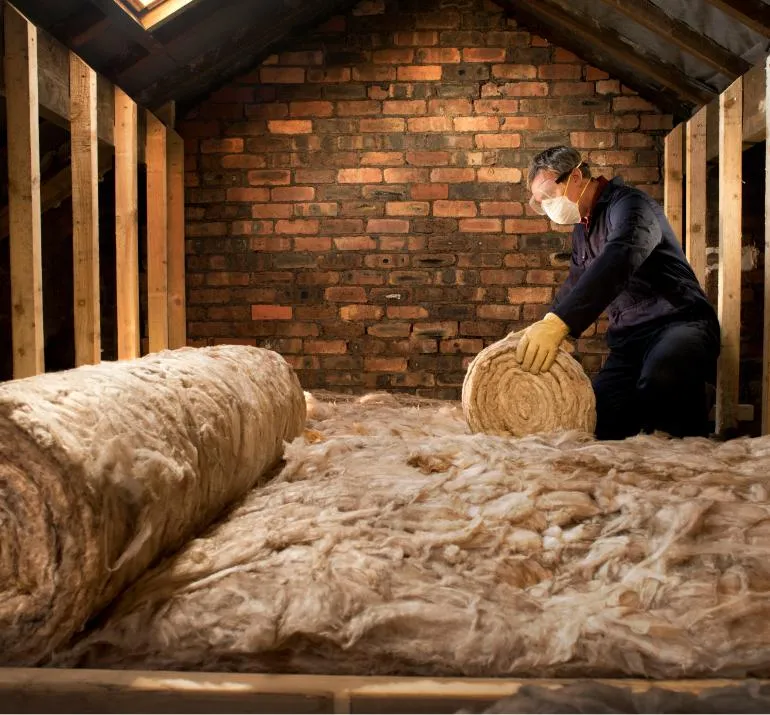INSULATION EXPERTS IN KENSINGTON
Batt & Roll Insulation

Kensington Batt & Roll Specialists
In addition to other insulation methods, batt and roll insulation stands out for its simplicity and cost-effectiveness. We've found that many homeowners and builders prefer this type of insulation because it's straightforward to install and provides effective thermal resistance. It consists of flexible fibers, typically fiberglass or mineral wool, which are manufactured into large rolls or pre-cut panels, known as batts.
We particularly appreciate how batt and roll insulation can be easily fitted between studs, joists, and beams, making it ideal for new construction projects as well as retrofitting existing homes. It's available in various thicknesses and densities, allowing us to choose the right R-value needed to meet local building codes and climate conditions.
Moreover, we've noticed that it helps in significantly reducing heat transfer, which in turn can lower heating and cooling costs for homeowners. It's also worth mentioning that it provides a decent level of soundproofing. Handling batt and roll insulation requires basic safety gear like gloves and masks because fibers can irritate the skin and respiratory system. However, with the right precautions, it's a job we can manage efficiently and safely.
Installation Tips for Batt & Roll Insulation
While installing batt and roll insulation might seem straightforward, ensuring a proper fit is crucial for maximizing its effectiveness. We've gathered some key tips to help you get the job done right. First, always measure the space you're insulating before purchasing your materials. It's vital to choose the correct thickness and width to ensure there are no gaps that can allow heat transfer.
When you're ready to install, start from one corner and work your way across, making sure each piece fits snugly between the framing studs. If you encounter electrical boxes or other obstacles, carefully cut the insulation to fit around them without compressing the material. This might require some patience, but it's worth the effort for the energy efficiency gains.
Don't forget to wear protective gear, including gloves, a mask, and safety glasses. Fiberglass particles can irritate the skin and respiratory system, so it's better to be safe than sorry.
Spray Foam Versus Batt & Roll Insulation
Comparing spray foam and batt & roll insulation reveals key differences that impact their effectiveness and suitability for various home environments. Spray foam insulation, known for its high R-value per inch, provides superior air sealing properties. It expands into small crevices and gaps, creating a tight seal that significantly reduces air leakage and the intrusion of moisture. This makes it ideal for spaces where air leaks are common, such as attics and basements.
On the other hand, batt & roll insulation, typically made from fiberglass or mineral wool, is more traditional and cost-effective. It's easier to install, especially in spaces with standard joist and stud spacing that don't require extensive cutting or fitting. However, it doesn't seal as tightly as spray foam, which can lead to higher energy bills due to air leaks.
We've found that the choice between these two types often comes down to budget and specific home needs. Spray foam is generally more expensive upfront but can offer savings on energy bills due to its air sealing capabilities. Batt & roll, while less expensive, might require additional sealing measures to match the energy efficiency of spray foam.
Selecting Insulation for Your Home
Choosing the right insulation for your home involves understanding the various types available and their specific benefits. We've previously discussed blown-in insulation, which is great for fitting into odd spaces and gaps. However, there are other types worth considering depending on your needs.
Batt and roll insulation, commonly made from fiberglass or mineral wool, is an excellent choice for straightforward, regular spaces like walls and attics. It's relatively easy to install, and it's effective for reducing heat transfer, which makes it a popular choice among homeowners.
If you're looking for something that also acts as a radiant barrier, reflective insulation might be your best bet. This type reflects heat away from your home, making it particularly useful in hot climates. It's typically installed in attics to keep heat from penetrating into living spaces below.
For those hard-to-reach areas or where higher insulation levels are required, injected foam could be the solution. It expands to fill cavities, providing a high R-value and excellent air sealing.
Each type of insulation has its unique installation challenges and performance characteristics. We're here to help you navigate these options to find the perfect fit for your home.
Take 10% Off Any Job Over $5,000
Our work is guaranteed to satisfy.

Get a free quote
Fill out the form below to request a free consultation
Connect With Us
© Copyright 2025 Kensington Spray Foam. All Rights Reserved.
Zip codes we serve:20895,20891,20896,20889,20814,20902,20892,20894,20852,20910,20815,20810,20811,20813,20824,20825,20827,20511,20916,20997,20907,20908,20911,20915,20918,20901,20015,20906,20851,20012,20897,20913,20817,20047

